Best Overall Bass
Strings for Metal
-
Overall: 9.5/10
-
Best Feature: Handmade in England for quality control
-
TedScore™: 9.5/10
Best Durable
Bass
Strings for Metal
-
Overall: 9/10
-
Best Feature: Hand-wound in the USA for quality control
-
TedScore™: 9/10
Best Budget-Friendly
Bass Strings for Metal
-
Overall: 9/10
-
Best Feature: Precision winding for consistency and accuracy
-
TedScore™: 9/10
Finding the best bass strings unlocks the secret to achieving that ideal metal tone. They release a mighty, visceral sound that electrifies the audience.
But where do you begin with a seemingly endless sea of options?
Fear not, because I’ve got you covered.
In this article, I’ll dive deep into the world of bass strings for metal, and explore the tried-and-true classics that have been rocking stages for ages.
And if you want to know right at the start my top pick; it’s the Rotosound Swing Bass 66. They sound simply amazing, and I’ve used them for many years.
So whether you’re a seasoned metal maestro or just starting on your epic musical journey, there’s something here for everyone.
Get ready to discover the perfect set of bass strings that will make you the driving force behind your band’s intense, ear-shredding sound!
Choosing the Right Bass Strings for Metal
Gauge Matters
The gauge and material of your bass strings are crucial factors that determine the tone and playability of your instrument.
which affects the tension and feel of the strings. Lighter gauge strings are easier to play and work well for styles like funk and country. However, for metal, heavier gauge strings are generally preferred.
that works well with the heavy distortion and fast playing common in metal.
Recommended Gauges for Metal Bass Playing
Heavier gauges are generally preferred for their thicker sound and increased sustain. A thicker gauge also provides more tension, which can help with precision and speed.
Here are some recommended gauges for metal bass playing:
This is a standard gauge for metal bass playing. It provides a balanced tone and good playability.
This heavier gauge provides more tension and a thicker sound. It’s ideal for players who want a more aggressive tone.
This extra-heavy gauge provides maximum tension and a massive, thick sound. It’s ideal for players who want a very aggressive and heavy tone.
String Materials for Metal
In metal, tone is everything. You want your bass to cut through the mix and be heard. Choosing the right bass strings can help you achieve the tone you’re looking for.
Here are some of the most common materials used for metal bass strings:
Stainless steel
Nickel-plated steel
Cobalt
Flatwound strings
Coated bass strings
Sets are Key
Top 7 Bass Strings for Metal
When it comes to finding the best bass strings for metal, there are a few factors to consider. You want durable strings that produce a bright and consistent sound and are suitable for drop tuning.
Here are some of the top bass strings for metal:
D'Addario NYXL Nickel Wound Bass Strings
Best STRINGS FOR DARKER TONES
Daddario NYXL4095, Bass Gtr String Set Long Scale Super Light 40-95
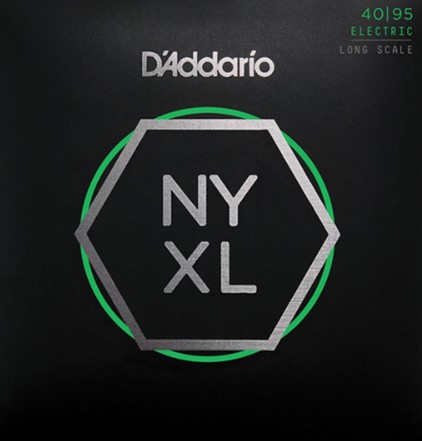
FEATURES:
- High carbon steel alloy core for enhanced strength and durability
- NYXL nickel-plated wrap wire for improved tone and sustain, and reduced finger noise
- Reformulated nickel-plated steel windings for increased magnetic output and clarity in the low-end
- Improved tonal response for clarity and definition in metal music
- Enhanced durability for heavy playing and frequent use
- Reduced finger noise for fast and technical playing in metal music
- The guitar strings are not ideal for players who like a brighter tone
When you click ‘Check Price’, you’ll see there are loads of great places to buy this item. Our personal favorite is Sweetwater for the US, and Thomann and Gear4Music for the UK & Europe.
They are the largest music retailers, with excellent customer service, competitive prices, really fast shipping, and the longest guarantees.
The professional musician who wrote this article combined many things,
from the product build, manufacturer’s reputation through to feedback
from other users, to create our famous TedScore™.
Ernie Ball Regular Slinky Bass Strings
Ernie Ball Regular Slinky Bass Strings are a popular choice among metal bass players due to their excellent balance of durability and tone.
These strings are constructed with nickel-plated steel windings, offering a bright, punchy sound that works well in metal genres.
The Regular Slinky gauge balances flexibility and tension, allowing for versatility in playing styles and techniques commonly used in metal music.
Best For PROFESSIONAL MUSICIANS
Ernie Ball Regular Slinky Nickel Bass Guitar Strings 50-105
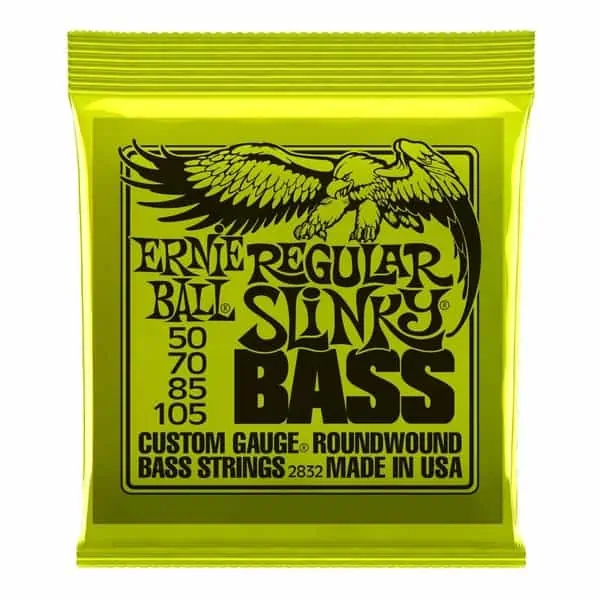
FEATURES:
- Nickel-plated steel wire wrap for balanced tone and smooth feel
- High-carbon steel hex core for strength and durability
-Precision winding for consistency and accuracy
- Bright and punchy tone for metal music
- Long-lasting durability for heavy playing and frequent use
- Smooth feel and balanced tone for fast and technical playing in metal music
- No vintage tones
When you click ‘Check Price’, you’ll see there are loads of great places to buy this item. Our personal favorite is Sweetwater for the US, and Thomann and Gear4Music for the UK & Europe.
They are the largest music retailers, with excellent customer service, competitive prices, really fast shipping, and the longest guarantees.
The professional musician who wrote this article combined many things,
from the product build, manufacturer’s reputation through to feedback
from other users, to create our famous TedScore™.
Rotosound Swing Bass 66 Stainless Steel Bass Strings
Rotosound Swing Bass 66 Stainless Steel Bass Strings are highly regarded among metal bass players for their distinctive tone and durability.
The stainless steel construction delivers a bright and aggressive sound that suits metal music’s heavy and aggressive nature.
The Swing Bass 66 gauge provides a tight and focused feel, perfect for fast and intricate playing styles often found in metal genres.
Best For metal bass tone
Rotosound RS66LD Stainless Steel Bass Guitar Strings, 45-105
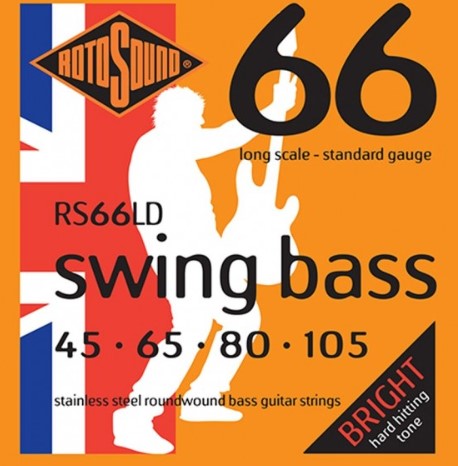
FEATURES:
- Stainless steel wrap wire for bright and punchy tone
- Hexagonal steel core for strength and durability
- Handmade in England for quality control
- Clear and articulate tone for metal music
- Withstand heavy playing and frequent use, ensuring their longevity and reliability
- Excellent sustain and harmonics for soloing and riffing in metal music
- May require some breaking-in time
- Higher tension may not suit all players
When you click ‘Check Price’, you’ll see there are loads of great places to buy this item. Our personal favorite is Sweetwater for the US, and Thomann and Gear4Music for the UK & Europe.
They are the largest music retailers, with excellent customer service, competitive prices, really fast shipping, and the longest guarantees.
The professional musician who wrote this article combined many things,
from the product build, manufacturer’s reputation through to feedback
from other users, to create our famous TedScore™.
DR Strings Hi-Beam Stainless Steel Bass Strings
DR Strings Hi-Beam Stainless Steel Bass Strings are popular among metal bass players due to their high output and balanced tone.
The stainless steel windings provide a bright, punchy sound with enhanced clarity and definition. These strings offer excellent sustain and articulation, allowing for precise and aggressive playing techniques.
The Hi-Beam construction also ensures durability and longevity, making them ideal for heavy playing and frequent string bending.
Best For high output and balanced tone
DR Strings LR-40 HI-BEAM Stainless Steel Bass Strings, 40-100

FEATURES:
- Stainless steel wrap wire for bright and punchy tone
- Round core wire for flexibility and sustain
- Compression winding for consistent tone and feel
- Clear and articulate tone for metal music
- Flexible and responsive feel for fast and technical playing in metal music.
- Have a balanced sound that allows for versatility in playing different styles of metal music
- May require some break-in time for optimal tone
When you click ‘Check Price’, you’ll see there are loads of great places to buy this item. Our personal favorite is Sweetwater for the US, and Thomann and Gear4Music for the UK & Europe.
They are the largest music retailers, with excellent customer service, competitive prices, really fast shipping, and the longest guarantees.
The professional musician who wrote this article combined many things,
from the product build, manufacturer’s reputation through to feedback
from other users, to create our famous TedScore™.
La Bella Deep Talkin' Bass Stainless Steel Bass Strings
La Bella Deep Talkin’ Bass Stainless Steel Bass Strings excel in providing the deep and heavy tones required in metal music.
These strings have a tight, focused sound that cuts through the mix effortlessly, making them perfect for metal genres characterized by aggressive and relentless bass rhythms.
The durability and longevity of La Bella Deep Talkin’ Bass Strings make them a reliable choice for intense playing and extended performance sessions.
Best For deep heavy metal tone
La Bella 760FS Deep Talkin' Bass Flat Wound Bass Strings

FEATURES:
- Stainless steel flat wound construction for a warm and mellow tone
- Hand-wound in the USA for quality control
- Tension balanced for even response across all strings
- Smooth and mellow tone for metal music with a vintage or classic sound
- Comfortable feel and reduced finger noise for fast and technical playing in metal music
- Provides a unique tonal character that can add depth and complexity to metal music
- Slightly higher price compared to other bass strings
- May require some adjustment to get used to the lower tension
When you click ‘Check Price’, you’ll see there are loads of great places to buy this item. Our personal favorite is Sweetwater for the US, and Thomann and Gear4Music for the UK & Europe.
They are the largest music retailers, with excellent customer service, competitive prices, really fast shipping, and the longest guarantees.
The professional musician who wrote this article combined many things,
from the product build, manufacturer’s reputation through to feedback
from other users, to create our famous TedScore™.
Dean Markley Blue Steel Bass Strings
Due to their unique cryogenic freeze treatment, Dean Markley Blue Steel Bass Strings are an excellent choice for metal bass players.
This process locks in the bright and punchy tone, allowing you to deliver cutting-edge basslines in metal music.
The stainless steel construction further enhances the clarity and projection, ensuring that your bass cuts through the mix with precision and assertiveness.
Best For bright punchy tone
Dean Markley XL Blue Steel (Stainless) Bass , 40-95
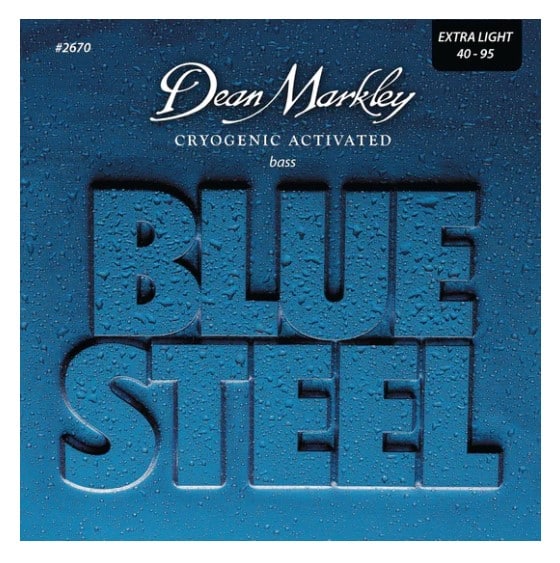
FEATURES:
- Cryogenically frozen stainless steel wrap wire for bright and punchy tone
- Hexagonal core wire for strength and durability
- Handmade in the USA for quality control
- Clear and articulate tone for metal music
- Reduced finger noise for fast and technical playing in metal music
- The cryogenic freezing process enhances the strings' longevity and tonal consistency
- May require some adjustment for players accustomed to different string tensions
- Costlier compared to some other bass string brands
When you click ‘Check Price’, you’ll see there are loads of great places to buy this item. Our personal favorite is Sweetwater for the US, and Thomann and Gear4Music for the UK & Europe.
They are the largest music retailers, with excellent customer service, competitive prices, really fast shipping, and the longest guarantees.
The professional musician who wrote this article combined many things,
from the product build, manufacturer’s reputation through to feedback
from other users, to create our famous TedScore™.
GHS Bass Boomers
GHS Bass Boomers have been a go-to choice for metal bassists due to their powerful and aggressive tone.
The nickel-plated steel construction delivers a bright yet balanced sound, providing the punch and clarity to drive heavy riffs in metal music.
The low-end solid presence and excellent sustain of the Bass Boomers make them an excellent choice for metal bassists looking to create a heavy and impactful sound.
Best For powerful and aggressive tone
GHS Bass Boomers Flea Signature Bass Strings, 045-105
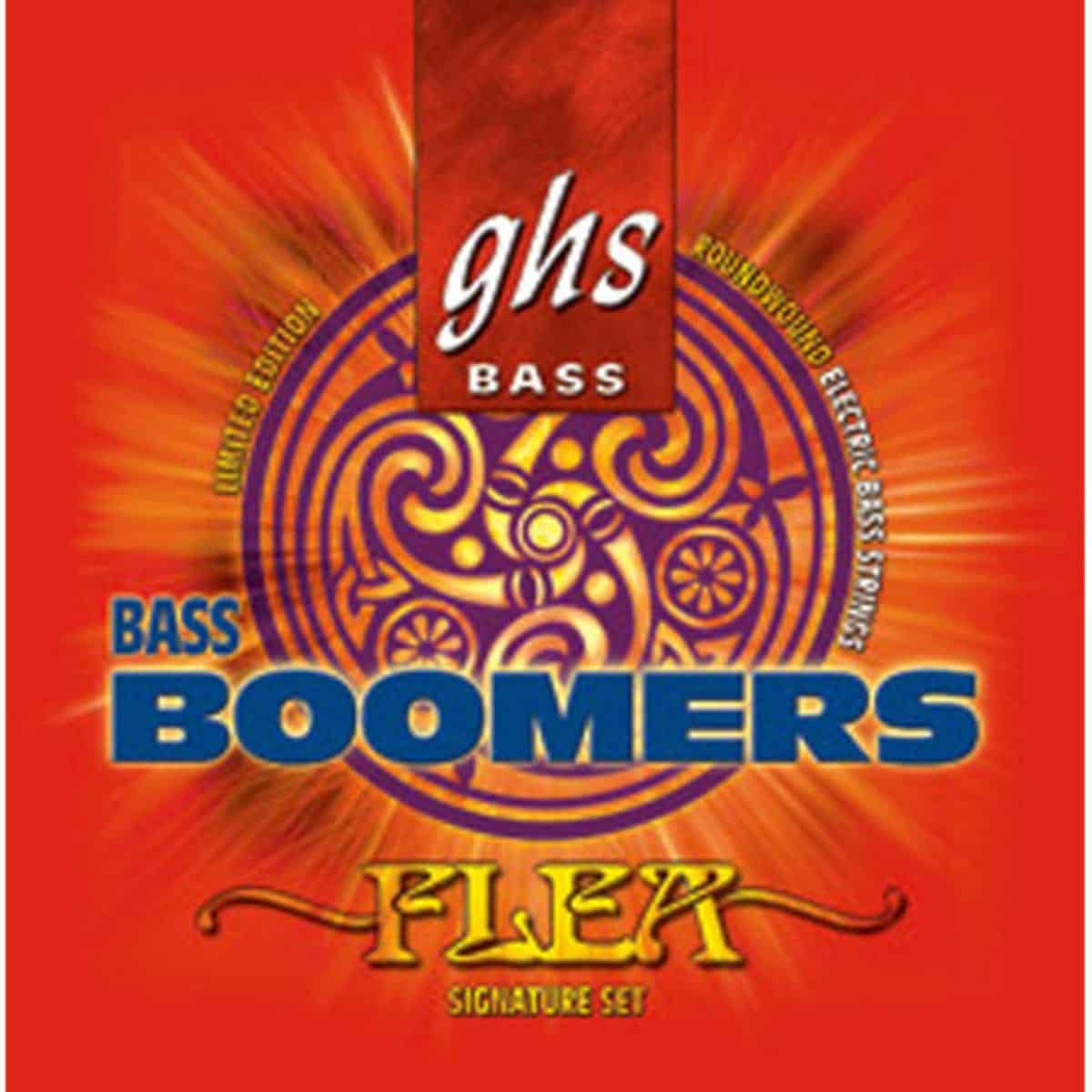
FEATURES:
- Roundwound nickel-plated steel wrap wire for bright and punchy tone
- Steel core wire for strength and durability
- Available in a wide range of gauges for customization
- Clear and articulate tone for metal music
- Excellent sustain and harmonics for soloing and riffing in metal music
- The wide range of gauges allows for customization of the strings
- May require some time to break in
- Not the most affordable option
When you click ‘Check Price’, you’ll see there are loads of great places to buy this item. Our personal favorite is Sweetwater for the US, and Thomann and Gear4Music for the UK & Europe.
They are the largest music retailers, with excellent customer service, competitive prices, really fast shipping, and the longest guarantees.
The professional musician who wrote this article combined many things,
from the product build, manufacturer’s reputation through to feedback
from other users, to create our famous TedScore™.
The Metal Genre
If you’re a bassist looking to play metal, it’s essential to understand the genre’s unique characteristics.
Metal is a subgenre of rock music that originated in the late 1960s and early 1970s. It’s characterized by its heavy, distorted sound, fast and aggressive tempo, and often dark and complex lyrics.
Metal has evolved over the years, giving rise to various sub-genres such as heavy metal, thrash metal, death metal, black metal, and many more.

Each sub-genre has its unique sound and style, but they all share the same core characteristics of loud, heavy, and aggressive music.
You must understand the genre’s rhythm and groove as a metal bassist. The bass plays a crucial role in metal music, providing the foundation for the guitar and drums while adding depth and complexity to the overall sound.
Characteristics of the Metal Genre Heavy, Distorted Guitar Riffs and Solos
One of the defining features of metal music is the heavy, distorted guitar sound. Metal guitarists often use drop tunings to achieve a deeper, more aggressive sound. Drop tunings involve lowering the pitch of one or more strings to create a heavier, more powerful sound. This technique is particularly effective for playing heavy, chugging riffs and solos.
Fast and Aggressive Drumming
Thick, Punchy Basslines
Emphasis on Low-End Frequencies
Care and Maintenance Techniques for Bass Strings
Taking care of your bass strings is essential to get the most out of them. Proper cleaning and maintenance techniques will help prolong the life of your strings and keep them sounding great for longer.
Here are some tips to help you maintain your metal bass strings:
Wipe your strings
string cleaner
Keep your bass in a case or gig bag
Avoid touching your strings
Changing Strings Regularly for Optimal Sound Quality
Regularly changing your bass strings is crucial to maintain optimal sound quality.
Over time, strings can become worn, dull, and lose their tone. Here are some tips to help you know when it’s time to change your strings:
If your strings feel rough or gritty to the touch, it’s time to change them. This indicates that they have become worn and no longer produce the same sound quality.

If your strings have lost their brightness or tone, it’s time to change them. This can happen over time as the lines become worn and lose elasticity.
If you notice that your bass is no longer staying in tune, it could be a sign that your strings need to be changed. Old strings can stretch and lose tension, causing your bass to go out of tune more frequently.
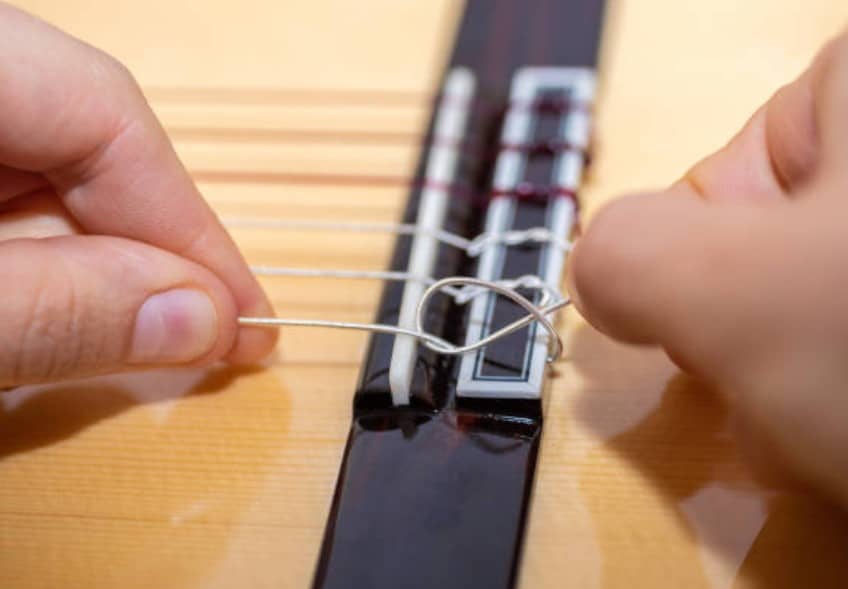
- If you’re playing regularly, you should aim to change your strings every 3-6 months. You can stretch this to once a year if you play less frequently.
Best Bass Strings For MetaL
Key Takeaways
Congratulations!
You’re now equipped with the knowledge to choose the best bass strings for your metal needs.
Remember, there’s no one-size-fits-all solution when it comes to bass strings. It depends on your preference, playing style, and desired tone.
In summary, I recommend considering the following factors when choosing bass strings for metal:
Gauge: Heavier gauges are better for drop tunings and provide a thicker, more powerful sound.
Material: Steel and nickel steel are great options for their bright, metallic sound and consistent low end.
Coating: Coated strings can provide a longer lifespan and reduce finger noise but may sacrifice some tone.
Brand: Popular brands such as DR Strings, Ernie Ball, and D’Addario are trusted for their quality and reliability.
Don’t be afraid to experiment with different brands and gauges to find the perfect fit. And remember, always change your strings regularly to maintain optimal tone and playability.
You can take your metal playing to the next level with the right bass strings.
So go out there and rock on!
Before you go…
Get ready to add some spice to your sound! Check out our Top 24 Best Bass Guitar Pedals For Beginners.
From funky wah-wah to face-melting distortion, I have the pedals to take your playing from good to great!
FAQ's
Bass strings with a heavier gauge and made from nickel or steel are ideal for playing metal.
Some popular options include D’Addario NYXL Nickel Wound Bass Strings and Ernie Ball Slinky Bass Strings.
Flatwound strings are not typically recommended for playing metal as they produce a smoother, less aggressive bass tone than roundwound strings.
Roundwound strings are better suited for metal music’s heavy, distorted sound.
For rock, bass strings with a medium gauge made from nickel or stainless steel are a good choice.
Some popular options include Ernie Ball Regular Slinky Bass Strings and Rotosound Swing Bass 66.
The most common metal bass tuning is drop D tuning, which involves tuning the lowest string (E) down to a D. Some metal bassists also use drop C or drop B tunings for even lower, heavier sounds.




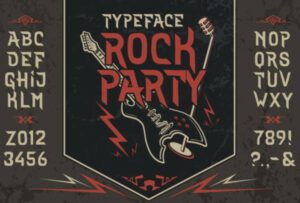







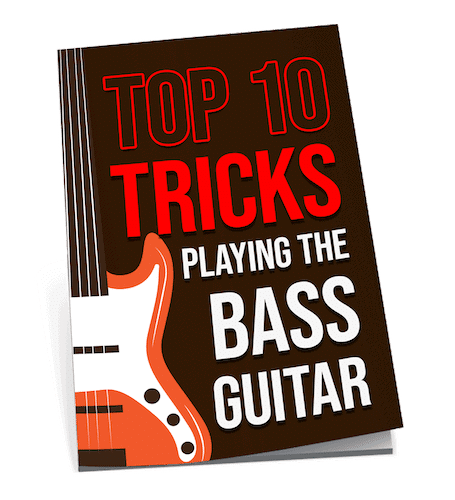
An intriguing compilation, Hugh Richardson. However, I must assert that while the choice of strings does play a significant role in tone shaping, the essence of metal can be captured through various means beyond mere material and gauge. The player’s touch, the technique, and even the bass itself contribute to the unique soundscape that defines the genre. Would it not be prudent to discuss these factors in conjunction with string choice to give readers a holistic understanding of metal bass tone creation?
So you’re telling me if I slap on some La Bella Deep Talkin’ Bass strings, I’ll instantly become the next metal legend? Sign me up, Hugh Richardson. Jokes aside, loved the guide. Now if only my skills could match my enthusiasm…
rotosound swing bass 66 strings are the real deal for metal no cap been using them for years and they never disappoint
Hey Hugh Richardson, got a question here. I’ve been using nickel-plated strings for a while, but I’m curious about switching to stainless steel after reading your section on string materials. Do they really make that much of a difference in getting a heavy metal tone, or is it more about how you play?
Hey Alex K., Mia here! I’ve experimented with both types and definitely notice a difference. Stainless steel strings tend to offer a brighter, more defined sound which is great for cutting through in metal mixes. It’s true technique plays a big role, but your string choice can really accentuate your tone. Hope this helps!